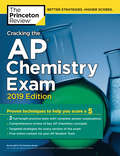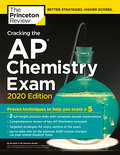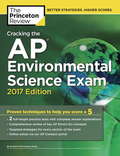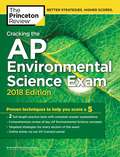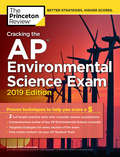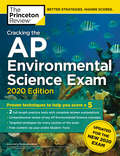- Table View
- List View
Cracking the AP Chemistry Exam, 2017 Edition: Proven Techniques to Help You Score a 5
by Princeton ReviewEVERYTHING YOU NEED TO HELP SCORE A PERFECT 5. Equip yourself to ace the AP Chemistry Exam with The Princeton Review's comprehensive study guide--including 2 full-length practice tests, thorough content reviews, access to our AP Connect Online Portal, and targeted strategies for every section of the exam.This eBook edition is optimized for on-screen learning with cross-linked questions, answers, and explanations.We don't have to tell you how tough AP Chem is--or how important a stellar exam score can be to your chances of getting into a top college of your choice. Written by Princeton Review experts who know their way around chem, Cracking the AP Chemistry Exam will give you the help you need to get the score you want.Techniques That Actually Work.* Tried-and-true strategies to help you avoid traps and beat the test* Tips for pacing yourself and guessing logically* Essential tactics to help you work smarter, not harderEverything You Need to Know to Help Achieve a High Score.* Comprehensive content review for all test topics* Up-to-date information on the 2017 AP Chemistry Exam* Engaging activities to help you critically assess your progress* Access to AP Connect, our online portal for helpful pre-college information and exam updatesPractice Your Way to Excellence.* 2 full-length practice tests with detailed answer explanations* Practice drills at the end of each content chapter* Review of important laboratory procedures and equipment
Cracking the AP Chemistry Exam, 2018 Edition: Proven Techniques to Help You Score a 5
by Princeton ReviewEVERYTHING YOU NEED TO HELP SCORE A PERFECT 5. Equip yourself to ace the AP Chemistry Exam with this comprehensive study guide—including 2 full-length practice tests, thorough content reviews, access to our AP Connect Online Portal, and targeted strategies for every section of the exam.Written by Princeton Review experts who know their way around chem, Cracking the AP Chemistry Exam will give you the help you need to get the score you want.This eBook edition is optimized for on-screen learning with cross-linked questions, answers, and explanations.Techniques That Actually Work.• Tried-and-true strategies to help you avoid traps and beat the test• Tips for pacing yourself and guessing logically• Essential tactics to help you work smarter, not harderEverything You Need to Know to Help Achieve a High Score.• Comprehensive content review for all test topics• Up-to-date information on the 2018 AP Chemistry Exam• Engaging activities to help you critically assess your progress• Access to AP Connect, our online portal for helpful pre-college information and exam updatesPractice Your Way to Excellence.• 2 full-length practice tests with detailed answer explanations• Practice drills at the end of each content chapter• Review of important laboratory procedures and equipment
Cracking the AP Chemistry Exam, 2019 Edition: Practice Tests & Proven Techniques to Help You Score a 5 (College Test Preparation)
by Princeton ReviewEVERYTHING YOU NEED TO HELP SCORE A PERFECT 5. Equip yourself to ace the AP Chemistry Exam with this comprehensive study guide—including 2 full-length practice tests, thorough content reviews, targeted strategies for every section, and access to online extras.Techniques That Actually Work.• Tried-and-true strategies to help you avoid traps and beat the test• Tips for pacing yourself and guessing logically• Essential tactics to help you work smarter, not harderEverything You Need to Know to Help Achieve a High Score.• Comprehensive content review for all test topics• Up-to-date information on the 2019 AP Chemistry Exam• Engaging activities to help you critically assess your progressPractice Your Way to Excellence.• 2 full-length practice tests with detailed answer explanations• Practice drills at the end of each content chapter• Review of important laboratory procedures and equipmentWritten by Princeton Review experts who know their way around chem, Cracking the AP Chemistry Exam will give you the help you need to get the score you want.
Cracking the AP Chemistry Exam, 2020 Edition: Practice Tests & Proven Techniques to Help You Score a 5 (College Test Preparation)
by The Princeton ReviewEVERYTHING YOU NEED TO HELP SCORE A PERFECT 5. Equip yourself to ace the AP Chemistry Exam with this comprehensive study guide—including 2 full-length practice tests, thorough content reviews, targeted strategies for every section, and access to online extras.Techniques That Actually Work.• Tried-and-true strategies to help you avoid traps and beat the test• Tips for pacing yourself and guessing logically• Essential tactics to help you work smarter, not harderEverything You Need to Know to Help Achieve a High Score.• Comprehensive content review for all test topics• Up-to-date information on the planned 2020 course changes via your online Student Tools• Engaging activities to help you critically assess your progress• Access to online study plans, a handy list of key equations, helpful pre-college information, and morePractice Your Way to Excellence.• 2 full-length practice tests with detailed answer explanations• Practice drills at the end of each content chapter• Review of important laboratory procedures and equipment
Cracking the AP Environmental Science Exam, 2012 Edition
by Princeton ReviewIf you need to know it, it's in this book! Cracking the AP Environmental Science Exam, 2012 Edition has been optimized for e-reader viewing with cross-linked questions, answers, and explanations. It includes: * Quick-study lists of important environmental science terms * A thorough review of all necessary laboratory exercises * A comprehensive guide for how to ace the free-response section of the exam * 2 full-length practice tests with detailed explanations * Updated strategies that reflect the AP test scoring change
Cracking the AP Environmental Science Exam, 2015 Edition
by Princeton ReviewEVERYTHING YOU NEED TO SCORE A PERFECT 5. Equip yourself to ace the AP Environmental Science Exam with The Princeton Review's comprehensive study guide--including thorough content reviews, targeted strategies for every question type, and 2 full-length practice tests with complete answer explanations. This eBook edition is optimized for on-screen learning with cross-linked questions, answers, and explanations.We don't have to tell you how tough AP Environmental Science is--or how important getting a stellar exam score can be to your chances of getting into your top-choice college. Written by the experts at The Princeton Review, Cracking the AP Environmental Science Exam arms you to take on the test with:Techniques That Actually Work.* Tried-and-true strategies to avoid traps and beat the test* Tips for pacing yourself and guessing logically* Essential tactics to help you work smarter, not harderEverything You Need to Know for a High Score.* Targeted review of commonly tested lab exercises* Helpful lists of key terms for every content review chapter* Engaging activities to help you critically assess your progressPractice Your Way to Perfection.* 2 full-length practice tests with detailed answer explanations and scoring worksheets* Practice drills at the end of each content review chapter* Quick-study "hit parade" of the terms you should know
Cracking the AP Environmental Science Exam, 2017 Edition: Proven Techniques to Help You Score a 5
by Princeton ReviewEVERYTHING YOU NEED TO HELP SCORE A PERFECT 5. Equip yourself to ace the AP Environmental Science Exam with The Princeton Review's comprehensive study guide--including thorough content reviews, targeted strategies for every question type, access to our AP Connect portal online, and 2 full-length practice tests with complete answer explanations. This eBook edition has been optimized for on-screen viewing with cross-linked questions, answers, and explanations.We don't have to tell you how tough AP Environmental Science is--or how important getting a stellar exam score can be to your chances of getting into your top-choice college. Written by the experts at The Princeton Review, Cracking the AP Environmental Science Exam arms you to take on the test and achieve your highest possible score.Techniques That Actually Work.* Tried-and-true strategies to help you avoid traps and beat the test* Tips for pacing yourself and guessing logically* Essential tactics to help you work smarter, not harderEverything You Need to Know to Help Achieve a High Score.* Targeted review of commonly tested lab exercises* Useful lists of key terms for every content review chapter* Engaging activities to help you critically assess your progress* Access to AP Connect, our online portal for helpful pre-college information and exam updatesPractice Your Way to Excellence.* 2 full-length practice tests with detailed answer explanations and scoring worksheets* Practice drills at the end of each content review chapter* Quick-study "hit parade" of the terms you should know
Cracking the AP Environmental Science Exam, 2018 Edition: Proven Techniques to Help You Score a 5
by Princeton ReviewEVERYTHING YOU NEED TO HELP SCORE A PERFECT 5. Equip yourself to ace the AP Environmental Science Exam with this comprehensive study guide—including thorough content reviews, targeted strategies for every question type, access to our AP Connect portal online, and 2 full-length practice tests with complete answer explanations. This eBook edition has been optimized for on-screen reading with cross-linked questions, answers, and explanations. Written by the experts at The Princeton Review, Cracking the AP Environmental Science Exam arms you to take on the test and achieve your highest possible score.Techniques That Actually Work.• Tried-and-true strategies to help you avoid traps and beat the test• Tips for pacing yourself and guessing logically• Essential tactics to help you work smarter, not harderEverything You Need to Know to Help Achieve a High Score.• Targeted review of commonly tested lab exercises• Useful lists of key terms for every content review chapter• Engaging activities to help you critically assess your progress• Access to AP Connect, our online portal for helpful pre-college information and exam updatesPractice Your Way to Excellence.• 2 full-length practice tests with detailed answer explanations and scoring worksheets• Practice drills at the end of each content review chapter• Quick-study “hit parade” of the terms you should know
Cracking the AP Environmental Science Exam, 2019 Edition: Practice Tests & Proven Techniques to Help You Score a 5 (College Test Preparation)
by Princeton ReviewEVERYTHING YOU NEED TO HELP SCORE A PERFECT 5. Ace the AP Environmental Science Exam with this comprehensive study guide—including 2 full-length practice tests with complete explanations, thorough content reviews, targeted strategies for every question type, and access to online extras. Techniques That Actually Work.• Tried-and-true strategies to help you avoid traps and beat the test• Tips for pacing yourself and guessing logically• Essential tactics to help you work smarter, not harderEverything You Need to Know to Help Achieve a High Score.• Targeted review of commonly tested lab exercises• Useful lists of key terms for every content review chapter• Engaging activities to help you critically assess your progress• Access to online study plans, a handy list of key terms and concepts, helpful pre-college information, and morePractice Your Way to Excellence.• 2 full-length practice tests with detailed answer explanations and scoring worksheets• Practice drills at the end of each content review chapter• Quick-study glossary of the terms you should knowWritten by the experts at The Princeton Review, Cracking the AP Environmental Science Exam arms you to take on the test and achieve your highest possible score.
Cracking the AP Environmental Science Exam, 2020 Edition: Practice Tests & Prep for the NEW 2020 Exam (College Test Preparation)
by The Princeton ReviewEVERYTHING YOU NEED TO HELP SCORE A PERFECT 5. Ace the 2020 AP Environmental Science Exam with this comprehensive study guide—including 2 full-length practice tests with complete explanations, thorough content reviews, targeted strategies for every question type, and access to online extras. Techniques That Actually Work.• Tried-and-true strategies to help you avoid traps and beat the test• Tips for pacing yourself and guessing logically• Essential tactics to help you work smarter, not harderEverything You Need to Know to Help Achieve a High Score. • Targeted review of commonly tested concepts for the AP® Environmental Science 2020 Exam• Detailed figures, graphs, and charts to illustrate important world environmental phenomena• Thorough lists of key terms for every content chapter• Access to study plans, helpful pre-college information, and more via your online Student ToolsPractice Your Way to Excellence.• 2 full-length practice tests with detailed answer explanations and scoring worksheets• Practice drills at the end of each content review chapter• Quick-study glossary of the terms you should knowWritten by the experts at The Princeton Review, Cracking the AP Environmental Science Exam gives you the tools you need for the score you want.
Cracking the AP Physics 1 Exam 2018, Premium Edition
by Princeton ReviewPREMIUM PRACTICE FOR A PERFECT 5! Ace the AP Physics 1: Algebra-Based Exam with this Premium version of The Princeton Review's comprehensive study guide.In addition to all the great material in our classic Cracking the AP Physics 1 Exam guide—which includes thorough content reviews, targeted test strategies, and access to online extras via our AP Connect portal—this edition includes extra exams, for a total of 5 full-length practice tests with complete answer explanations!This eBook edition is optimized for on-screen learning with cross-linked questions, answers, and explanations.Everything You Need to Know to Help Achieve a High Score.• Comprehensive content reviews for all test topics—including kinematics, dynamics, Newton's laws, work, energy, rotational motion, electrostatics, DC circuits, mechanical waves, sound, and more• Tons of charts and figures to illustrate concepts• Access to AP Connect, our online portal for helpful pre-college information and exam updatesPremium Practice to Help Achieve Excellence.• 4 full-length practice tests in the book with detailed answer explanations• 1 additional full-length practice test online with detailed answer explanations• Practice drills at the end of each content review chapter• Step-by-step walk-throughs of sample questionsTechniques That Actually Work.• Tried-and-true strategies to help you avoid traps and beat the test• Tips for pacing yourself and guessing logically• Essential tactics to help you work smarter, not harder
Cracking the AP Physics 1 Exam 2019, Premium Edition: 5 Practice Tests + Complete Content Review (College Test Preparation)
by Princeton ReviewPREMIUM PRACTICE FOR A PERFECT 5! Ace the AP Physics 1: Algebra-Based Exam with this Premium version of The Princeton Review's comprehensive study guide. Includes 5 full-length practice exams, thorough content reviews, targeted test strategies, and access to online extras.Everything You Need to Know to Help Achieve a High Score.• Comprehensive content reviews for all test topics—including kinematics, dynamics, Newton's laws, work, energy, rotational motion, electrostatics, DC circuits, mechanical waves, sound, and more• Tons of charts and figures to illustrate concepts• Access to online study plans, a handy list of key terms and concepts, helpful pre-college information, and more through our AP Student Tools portalPremium Practice to Help Achieve Excellence.• 4 full-length practice tests in the book with detailed answer explanations• 1 additional full-length practice test online with detailed answer explanations• Practice drills at the end of each content review chapter• Step-by-step walk-throughs of sample questionsTechniques That Actually Work.• Tried-and-true strategies to help you avoid traps and beat the test• Tips for pacing yourself and guessing logically• Essential tactics to help you work smarter, not harder
Cracking the AP Physics 1 Exam 2020, Premium Edition: 5 Practice Tests + Complete Content Review (College Test Preparation)
by The Princeton ReviewPREMIUM PRACTICE FOR A PERFECT 5! Ace the AP Physics 1 Exam with this Premium version of The Princeton Review's comprehensive study guide. Includes 5 full-length practice exams, plus thorough content reviews, targeted test strategies, and access to online extras.Techniques That Actually Work.• Tried-and-true strategies to help you avoid traps and beat the test• Tips for pacing yourself and guessing logically• Essential tactics to help you work smarter, not harderEverything You Need to Know to Help Achieve a High Score.• Comprehensive coverage of kinematics, dynamics, Newton's laws, work, energy, rotational motion, electrostatics, DC circuits, mechanical waves, sound, and more• Tons of charts and figures to illustrate concepts• Access to study plans, a handy list of formulas, and up-to-date info on the planned 2020 course changes via your online Student ToolsPremium Practice for AP Excellence.• 4 full-length practice tests in the book with detailed answer explanations• 1 full-length practice test online with detailed answer explanations• Practice drills at the end of each content review chapter• Step-by-step walk-throughs of sample questions
Cracking the AP Physics 1 Exam, 2015 Edition
by Princeton ReviewEVERYTHING YOU NEED TO HELP SCORE A PERFECT 5. Equip yourself to ace the new AP Physics 1 Exam with The Princeton Review's comprehensive study guide--including thorough content reviews, targeted strategies for every question type, and 2 full-length practice tests with complete answer explanations. This eBook edition has been optimized for on-screen viewing with cross-linked questions, answers, and explanations.We don't have to tell you how tough the AP Physics 1: Algebra-Based course is to master--or how vital a stellar exam can be to making your college application competitive at the most selective schools. Written by the experts at The Princeton Review, Cracking the AP Physics 1 Exam arms you to take on this new course and test and achieve your highest possible score.Techniques That Actually Work.* Tried-and-true strategies to avoid traps and beat the test* Tips for pacing yourself and guessing logically* Essential tactics to help you work smarter, not harderEverything You Need to Know for a High Score.* Comprehensive content reviews for all test topics* Up-to-date information on the 2015 AP Physics 1 Exam* Engaging activities to help you critically assess your progressPractice Your Way to Perfection.* 2 full-length practice tests with detailed answer explanations* Practice drills at the end of each content review chapter* Step-by-step walkthroughs of sample questions
Cracking the AP Physics 1 Exam, 2017 Edition: Proven Techniques to Help You Score a 5
by Princeton ReviewEVERYTHING YOU NEED TO HELP SCORE A PERFECT 5. Equip yourself to ace the AP Physics 1 Exam with The Princeton Review's comprehensive study guide--including thorough content reviews, targeted strategies for every question type, access to our online AP Connect portal, and 2 full-length practice tests with complete answer explanations. This eBook edition has been optimized for onscreen viewing with cross-linked questions, answers, and explanations.We don't have to tell you how tough the AP Physics 1: Algebra-Based course is to master--or how vital a stellar exam can be to making your college application competitive at the most selective schools. Written by the experts at The Princeton Review, Cracking the AP Physics 1 Exam arms you to take on the test and achieve your highest possible score.Techniques That Actually Work.* Tried-and-true strategies to avoid traps and beat the test* Tips for pacing yourself and guessing logically* Essential tactics to help you work smarter, not harderEverything You Need to Know to Help Achieve a High Score.* Comprehensive content reviews for all test topics--including kinematics, dynamics, Newton's laws, work, energy, rotational motion, electrostatics, DC circuits, mechanical waves, sound, and more* Tons of charts and figures to illustrate concepts* Access to AP Connect, our online portal for helpful pre-college information and exam updatesPractice Your Way to Excellence.* 2 full-length practice tests with detailed answer explanations* Practice drills at the end of each content review chapter* Step-by-step walk-throughs of sample questions
Cracking the AP Physics 1 Exam, 2018 Edition: Proven Techniques to Help You Score a 5
by Princeton ReviewEVERYTHING YOU NEED TO HELP SCORE A PERFECT 5! Ace the AP Physics 1: Algebra-Based Exam with this comprehensive study guide—including 2 full-length practice tests with complete answer explanations, thorough content reviews, targeted exam strategies, and access to our online AP Connect portal. This eBook edition has been optimized for on-screen reading with cross-linked questions, answers, and explanations. Written by the experts at The Princeton Review, Cracking the AP Physics 1 Exam arms you to take on the test and achieve your highest possible score.Everything You Need to Know to Help Achieve a High Score.• Comprehensive content reviews for all test topics—including kinematics, dynamics, Newton's laws, work, energy, rotational motion, electrostatics, DC circuits, mechanical waves, sound, and more• Tons of charts and figures to illustrate concepts• Engaging activities to help you critically assess your progress• Access to AP Connect, our online portal for helpful pre-college information and exam updatesPractice Your Way to Excellence.• 2 full-length practice tests with detailed answer explanations• Practice drills at the end of each content review chapter• Step-by-step walk-throughs of sample questionsTechniques That Actually Work.• Tried-and-true strategies to avoid traps and beat the test• Tips for pacing yourself and guessing logically• Essential tactics to help you work smarter, not harder
Cracking the AP Physics 1 Exam, 2019 Edition: Practice Tests & Proven Techniques to Help You Score a 5 (College Test Preparation)
by Princeton ReviewEVERYTHING YOU NEED TO HELP SCORE A PERFECT 5! Ace the AP Physics 1: Algebra-Based Exam with this comprehensive study guide—including 2 full-length practice tests with complete answer explanations, thorough content reviews, targeted exam strategies, and access to our online AP Connect portal. Everything You Need to Know to Help Achieve a High Score.• Comprehensive content reviews for all test topics—including kinematics, dynamics, Newton's laws, work, energy, rotational motion, electrostatics, DC circuits, mechanical waves, sound, and more• Tons of charts and figures to illustrate concepts• Engaging activities to help you critically assess your progress• Access to online study plans, a handy list of key terms and concepts, helpful pre-college information, and morePractice Your Way to Excellence.• 2 full-length practice tests with detailed answer explanations• Practice drills at the end of each content review chapter• Step-by-step walk-throughs of sample questionsTechniques That Actually Work.• Tried-and-true strategies to avoid traps and beat the test• Tips for pacing yourself and guessing logically• Essential tactics to help you work smarter, not harderWritten by the experts at The Princeton Review, Cracking the AP Physics 1 Exam arms you to take on the test and achieve your highest possible score.
Cracking the AP Physics 1 Exam, 2020 Edition: Practice Tests & Proven Techniques to Help You Score a 5 (College Test Preparation)
by The Princeton ReviewEVERYTHING YOU NEED TO HELP SCORE A PERFECT 5! Ace the AP Physics 1 Exam with this comprehensive study guide—including 2 full-length practice tests with complete answer explanations, thorough content reviews, targeted exam strategies, and access to our online Student Tools portal. Techniques That Actually Work.• Tried-and-true strategies to avoid traps and beat the test• Tips for pacing yourself and guessing logically• Essential tactics to help you work smarter, not harderEverything You Need to Know to Help Achieve a High Score.• Comprehensive coverage of kinematics, dynamics, Newton's laws, work, energy, rotational motion, electrostatics, DC circuits, mechanical waves, sound, and more• Tons of charts and figures to illustrate concepts• Engaging activities to help you critically assess your progress• Access to study plans, a handy list of formulas, and up-to-date info on the planned 2020 course changes via your online Student ToolsPractice Your Way to Excellence.• 2 full-length practice tests with detailed answer explanations• Practice drills at the end of each content review chapter• Step-by-step walk-throughs of sample questions
Cracking the AP Physics 2 Exam, 2016 Edition
by Princeton ReviewEVERYTHING YOU NEED TO HELP SCORE A PERFECT 5. Equip yourself to ace the new AP Physics 2 Exam with The Princeton Review's comprehensive study guide--including thorough content reviews, targeted strategies for every question type, and 2 full-length practice tests with complete answer explanations. This eBook edition has been specially formatted for on-screen viewing with cross-linked questions, answers, and explanations.We don't have to tell you how tough the AP Physics 2: Algebra-Based course is to master--or how vital a stellar exam can be to making your college application competitive at the most selective schools. Written by the experts at The Princeton Review, Cracking the AP Physics 2 Exam arms you to take on this new course and test and achieve your highest possible score.Techniques That Actually Work.* Tried-and-true strategies to avoid traps and beat the test* Tips for pacing yourself and guessing logically* Essential tactics to help you work smarter, not harderEverything You Need to Know to Help Achieve a High Score.* Comprehensive content reviews for all test topics--including thermodynamics; fluid statics and dynamics; electrostatics; magnetic fields; electromagnetism; geometric and physical optics; and more* Up-to-date information on the 2016 AP Physics 2 Exam* Engaging activities to help you critically assess your progress* Access to AP Connect, our online portal for helpful pre-college information and exam updatesPractice Your Way to Excellence.* 2 full-length practice tests with detailed answer explanations* Practice drills at the end of each content review chapter* Step-by-step walkthroughs of sample questions
Cracking the AP Physics 2 Exam, 2017 Edition: Proven Techniques to Help You Score a 5
by Princeton ReviewEVERYTHING YOU NEED TO HELP SCORE A PERFECT 5. Equip yourself to ace the AP Physics 2 Exam with The Princeton Review's comprehensive study guide--including thorough content reviews, targeted strategies for every question type, and 2 full-length practice tests with complete answer explanations. This eBook has been optimized for on-screen viewing with cross-linked questions, answers, and explanations.We don't have to tell you how tough the AP Physics 2: Algebra-Based course is to master--or how vital a stellar exam can be to making your college application competitive at the most selective schools. Written by the experts at The Princeton Review, Cracking the AP Physics 2 Exam arms you to take on this course and test and achieve your highest possible score.Techniques That Actually Work.* Tried-and-true strategies to avoid traps and beat the test* Tips for pacing yourself and guessing logically* Essential tactics to help you work smarter, not harderEverything You Need to Know to Help Achieve a High Score.* Comprehensive content reviews for all test topics--including thermodynamics; fluid statics and dynamics; electrostatics; magnetic fields; electromagnetism; geometric and physical optics; and more* Tons of charts and figures that illustrate key concepts* Engaging activities to help you critically assess your progress* Access to AP Connect, our online portal for helpful pre-college information and exam updatesPractice Your Way to Excellence.* 2 full-length practice tests with detailed answer explanations* Practice drills at the end of each content review chapter* Step-by-step walk-throughs of sample questions
Cracking the AP Physics 2 Exam, 2018 Edition: Proven Techniques to Help You Score a 5
by Princeton ReviewEVERYTHING YOU NEED TO HELP SCORE A PERFECT 5! Ace the AP Physics 2: Algebra-Based Exam with this comprehensive study guide—including 2 full-length practice tests with complete answer explanations, thorough content reviews, targeted exam strategies, and access to our AP Connect portal online. This eBook edition has been optimized for on-screen reading with cross-linked questions, answers, and explanations. Written by the experts at The Princeton Review, Cracking the AP Physics 2 Exam arms you to take on this course and test and achieve your highest possible score.Everything You Need to Know to Help Achieve a High Score.• Comprehensive content reviews for all test topics—including thermodynamics; fluid statics and dynamics; electrostatics; magnetic fields; electromagnetism; geometric and physical optics; and more• Tons of charts and figures that illustrate key concepts• Engaging activities to help you critically assess your progress• Access to AP Connect, our online portal for helpful pre-college information and exam updatesPractice Your Way to Excellence.• 2 full-length practice tests with detailed answer explanations• Practice drills at the end of each content review chapter• Step-by-step walk-throughs of sample questionsTechniques That Actually Work.• Tried-and-true strategies to avoid traps and beat the test• Tips for pacing yourself and guessing logically• Essential tactics to help you work smarter, not harder
Cracking the AP Physics 2 Exam, 2019 Edition: Practice Tests & Proven Techniques to Help You Score a 5 (College Test Preparation)
by Princeton ReviewEVERYTHING YOU NEED TO HELP SCORE A PERFECT 5! Ace the AP Physics 2: Algebra-Based Exam with this comprehensive study guide—including 2 full-length practice tests with complete explanations, thorough content reviews, targeted exam strategies, and access to online extras. Everything You Need to Know to Help Achieve a High Score.• Comprehensive coverage of thermodynamics; fluid statics and dynamics; electrostatics; magnetic fields; electromagnetism; geometric and physical optics; and more• Tons of charts and figures to illustrate key concepts• Engaging activities to help you critically assess your progress• Access to online study plans, a handy list of key terms and concepts, helpful pre-college information, and morePractice Your Way to Excellence.• 2 full-length practice tests with detailed answer explanations• Practice drills at the end of each content review chapter• Step-by-step walk-throughs of sample questionsTechniques That Actually Work.• Tried-and-true strategies to avoid traps and beat the test• Tips for pacing yourself and guessing logically• Essential tactics to help you work smarter, not harderWritten by the experts at The Princeton Review, Cracking the AP Physics 2 Exam arms you to take on this test and achieve your highest possible score.
Cracking the AP Physics 2 Exam, 2020 Edition: Practice Tests & Proven Techniques to Help You Score a 5 (College Test Preparation)
by The Princeton ReviewEVERYTHING YOU NEED TO HELP SCORE A PERFECT 5! Ace the AP Physics 2 Exam with this comprehensive study guide—including 2 full-length practice tests with complete explanations, thorough content reviews, targeted exam strategies, and access to online extras. Techniques That Actually Work.• Tried-and-true strategies to avoid traps and beat the test• Tips for pacing yourself and guessing logically• Essential tactics to help you work smarter, not harderEverything You Need to Know to Help Achieve a High Score.• Comprehensive coverage of thermodynamics, fluid statics and dynamics, electrostatics, magnetic fields, electromagnetism, geometric and physical optics, and more• Tons of charts and figures to illustrate key concepts• Up-to-date info on the planned 2020 course changes via your online Student Tools• Engaging activities to help you critically assess your progress• Access to online study plans, a handy list of equations and formulas, helpful pre-college information, and morePractice Your Way to Excellence.• 2 full-length practice tests with detailed answer explanations• Practice drills at the end of each content review chapter• Step-by-step walk-throughs of sample questions
Cracking the AP Physics B Exam, 2012 Edition
by Princeton ReviewIf you need to know it, it's in this book! Cracking the AP Physics B Exam, 2012 Edition has been optimized for e-reader viewing with cross-linked questions, answers, and explanations. It includes: * A comprehensive review of vectors, fluid mechanics, optics, atomic and nuclear physics, and more * Step-by-step strategies for cracking even the toughest problems * Detailed explanations for the free-response section of the exam * Updated strategies that reflect the AP test scoring change * 2 full-length practice tests with detailed explanations
Cracking the AP Physics C Exam, 2015 Edition
by Princeton ReviewEVERYTHING YOU NEED TO SCORE A PERFECT 5. Equip yourself to ace the AP Physics C Exam with The Princeton Review's comprehensive study guide--including thorough content reviews, targeted strategies for every question type, and 2 full-length practice tests with complete answer explanations. We don't have to tell you how tough AP Physics C is to master--or how vital a stellar exam can be to making your college application competitive at the most selective schools. Written by the experts at The Princeton Review, Cracking the AP Physics C Exam arms you to take on the test with:Techniques That Actually Work.* Tried-and-true strategies to avoid traps and beat the test* Tips for pacing yourself and guessing logically* Essential tactics to help you work smarter, not harderEverything You Need to Know for a High Score.* Comprehensive content reviews for all test topics* Up-to-date information on the 2015 AP Physics C Exam* Engaging activities to help you critically assess your progressPractice Your Way to Perfection.* 2 full-length practice tests with detailed answer explanations* Practice drills at the end of each content review chapter* Step-by-step walkthroughs of sample Mechanics and Electricity &Magnetism exam questions


